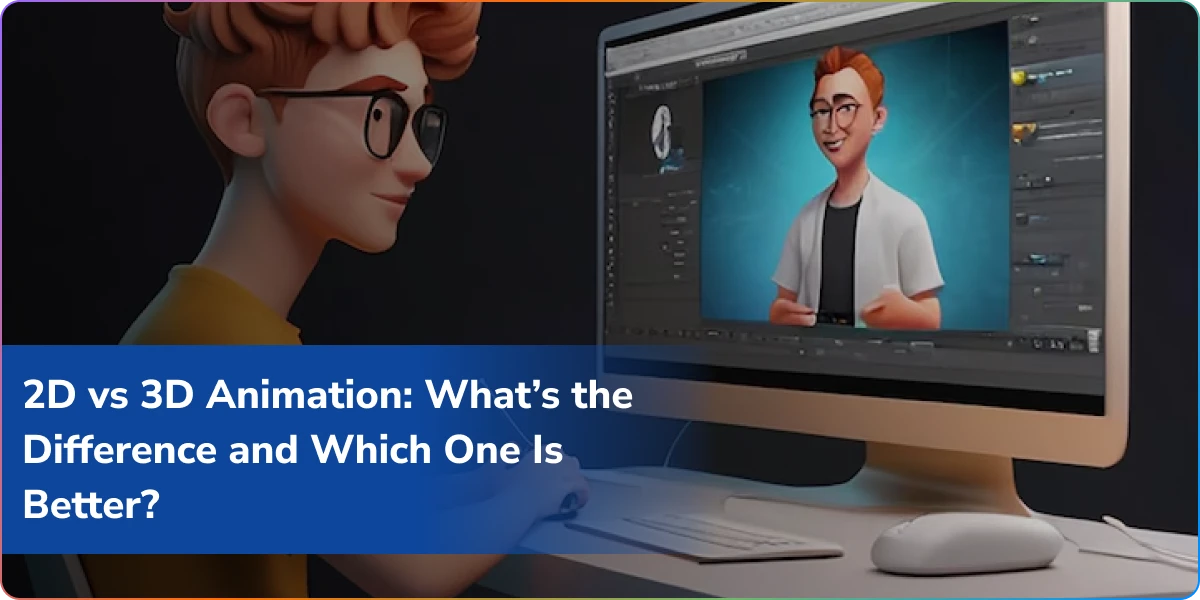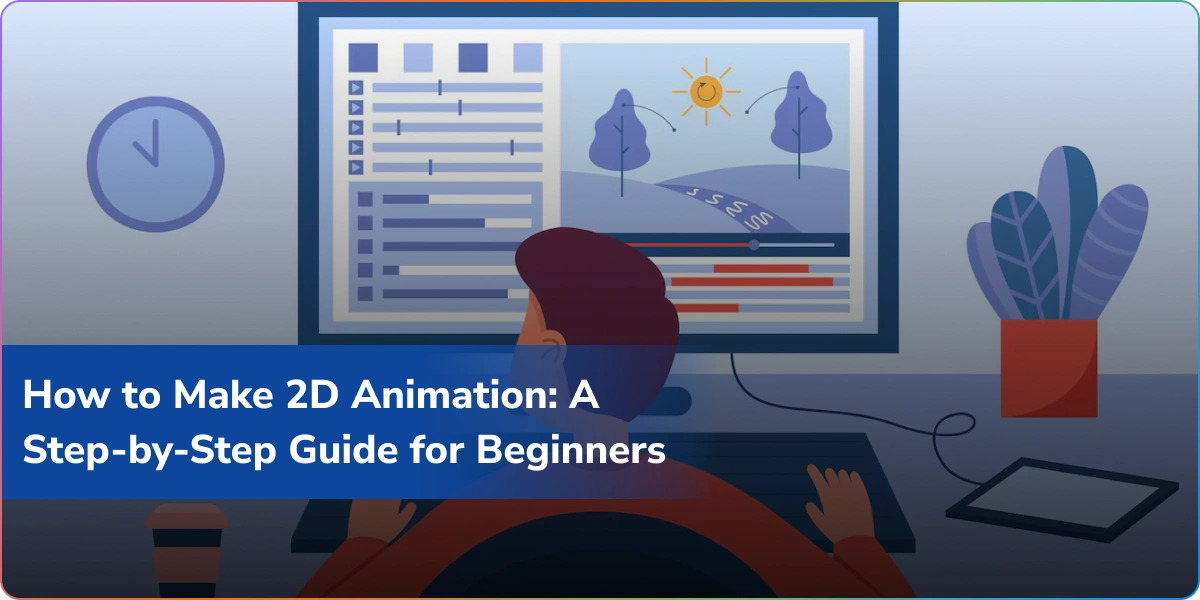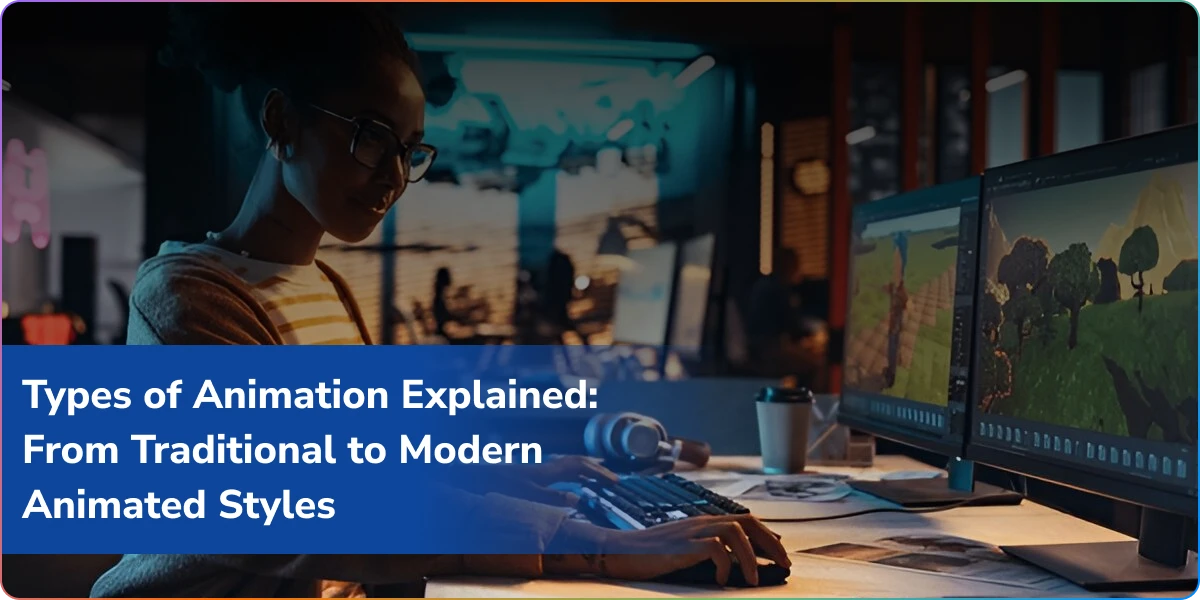Animation has evolved much from the beginnings of flipbooks and hand-drawn illustrations. Today, the two most prevalent types of animation are 2D and 3D animation. If you are a budding animator, a company wanting to produce visual content, or simply an avid fan of animated movies and games, knowing the distinction between 2D and 3D animation will enable you to select the correct medium for your purpose.
In this blog, we’re going to learn what is 2D animation, understand what is 3D animation, discuss the difference between 2D and 3D animation, and finally, assist you in making a decision—2D or 3D, what is best for your project?
What is 2D Animation?
2D animation involves producing movement in two dimensions. There are no depth, width, or height-only height and width. Traditional Disney animated films such as Snow White and the Seven Dwarfs and contemporary explainer videos utilize this technique.
While 2D and 3D animation both succeeded in the digital era, 2D animation continues to be sought after because it is easy and visually appealing. The artists sketch frame by frame or apply rigging methods using Adobe Animate, Toon Boom, or Synfig Studio.
Characteristics of 2D Animation:
- Operates on a flat surface (width and height)
- Characters are drawn by hand or illustrated using software
- Movement is based on frame by frame sequencing or rigging
- More artistic and stylized
What Is 3D Animation?
3D animation, however, refers to the production of characters and objects in a three-dimensional environment—height, width, and depth. Imagine Pixar’s Toy Story or DreamWorks’ How to Train Your Dragon. Characters are not sketched but carved out using software such as Blender, Maya, or Cinema 4D.
These movements are governed by digital skeletons or rigs. Lighting, textures, and camera angles contribute significantly to providing the visuals with realism or a cinematic look.
Characteristics of 3D Animation:
- Mimics real-world movement and depth
- Involves modeling, texturing, rigging, and rendering
- Highly realistic with perspective, shadows, and lighting
- Most commonly applied in games, simulations, and films
2D and 3D Animation Difference
Now let’s compare the 2D vs 3D animation based on critical aspects:
Feature 2D Animation 3D Animation
Dimensions Height and Width Height, Width, and Depth
Creation Method Hand-drawn or digital illustrations Sculpted using 3D software
Realism Stylized and artistic Realistic and immersive
Complexity Relatively simple More complex due to modeling and rendering
Production Time Shorter Longer
Cost Affordable Expensive due to software and skill set
Applications Cartoons, explainer videos, mobile apps Movies, video games, simulations
Understanding this difference between 2D and 3D animation is essential for making an informed decision.
Use Cases: Where Each Excels
1. Marketing and Advertising
- 2D animation finds extensive application in explainer videos, ads, and infographics. It’s easy to create and budget-friendly.
- 3D animation provides depth and impact to product demonstrations, making it perfectly suited for sectors such as tech, auto, and real estate.
2. Education and Training
- 2D animation breaks down complex subjects, making it perfectly suited for e-learning modules.
- 3D animation is best for depicting human anatomy, mechanical simulations, and interactive training.
3. Gaming and Entertainment
- 2D animation is prevalent in mobile games, anime, and web series.
- 3D animation is the norm in virtual reality applications, console games, and big-budget movies.
Advantages and Disadvantages of 2D Animation
Advantages:
- Affordable
- Quicker turnaround
- Less difficult to edit and revise
- Good artistic control
Disadvantages:
- Limited realism and depth
- May seem flat
- Needs drawing skill
Advantages and Disadvantages of 3D Animation
Pros:
- Extremely realistic graphics
- More freedom in camera movements and lightings
- More engaging experience
Cons:
- Time-consuming effort
- High-cost production
- Sloping learning curve
2D or 3D Which Is Better?
So, the million-dollar question—2D or 3D which is better? The answer is based on your purpose.
Go with 2D Animation if:
- You have a low budget
- You need quick turnaround
- You like a stylized aesthetic
- Your project is instructional or educational
Choose 3D Animation if:
- You need realism and detail
- Your content involves complex movements
- You have the resources and budget
- You’re creating content for entertainment or simulation
Remember, there’s no one-size-fits-all answer. The difference between 2D and 3D animation should guide your choice based on purpose, not preference alone.
How the Industry Uses 2D 3D Animation Together
Surprisingly, most contemporary productions integrate 2D 3D animation. As an example, animated television programs may have 3D landscapes with 2D characters, or the opposite, for financial savings and an interesting visual aesthetic. Such a mixed technique utilizes the best of both.
The Future of 2D and 3D Animation
With the development of AI tools and real-time rendering engines such as Unreal Engine and Unity, 2D and 3D animation are changing at a faster rate than ever before.
- 2D animation is becoming more dynamic due to rigging and automated tweening software.
- 3D animation is moving into AR/VR, producing immersive experiences for everything from shopping to surgery.
As the business expands, knowing the difference between 2D and 3D animation would be crucial not only for creators, but for brands, teachers, and developers as well.
Deciding on 2D or 3D for Your Business
Whether you’re starting a startup, marketing a product, or creating educational content, the decision on 2D vs 3D animation may affect your message delivery, audience interaction, and budget.
Questions to Consider:
- What’s your budget and deadline?
- Do you require realism or stylization?
- What is your platform (web, mobile, TV)?
- Who is your audience—kids, adult, technical?
Your responses will guide you to choose between 2D or 3D, whichever is suitable for your project’s success.
Conclusion
Whether it’s to teach, entertain, or promote, animation is one of the most effective tools to convey visually. By knowing the 2D and 3D animation difference, you can make wiser creative choices and turn your imagination into reality.
Need Assistance in Developing amazing 2D or 3D Animation? At Logixbuilt Solutions, we provide customized animation development services for brands, educators, startups, and media firms. We have professional animators to help you create attractive 2D explainer videos or movie-like 3D content.
Let’s get together and produce eye-catching animated content—contact us now!
FAQ’s
Q1: What is the primary difference between 2D and 3D animation?
The primary distinction between 2D and 3D animation is their visual space. 2D animation utilizes height and width, whereas 3D animation utilizes depth, providing greater realism.
Q2: What is 2D animation most suited for?
2D animation is most suited for explainer videos, mobile games, and stylized content that’s affordable and faster to make.
Q3: What is 3D animation used for?
3D animation is best suited for films, video games, product demonstrations, and anything that demands realistic visual effects.
Q4: 2D or 3D—which is the best for marketing?
It all depends on your audience and objectives. 2D animation is best suited for fast, informative videos. 3D animation brings wow factor to product launches or advertisements.
Q5: Is it possible to blend 2D and 3D animation?
Yes! Blending both for a distinct visual style and budget cost savings while still engaging is common for many projects.


